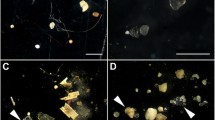Abstract
Heavy contaminant load released into the Northern Dvina River during flooding increased the concentrations of aliphatic (AHC) and polcyclic aromatic (PAH) hydrocarbons in water and bottom sediments. The composition of hydrocarbons was different from that of the summer low flow season. The concentrations of dissolved and particulate AHC ranged from 12 to 106 and from 192 to 599 μg/l, respectively, and bottom sediments contained from 26.2 to 329 μg/g AHC and 4 to 1785 ng/g PAH. As the transformation of AHC occurred at low spring temperatures, the alkane composition was shown to be dominated by terrigenous compounds, whereas more stable PAH showed elevated contents of petrogenic and pyrogenic compounds. It was also shown that the Northern Dvina-Dvina Bay geochemical barrier prevents contaminant input into the White Sea, i.e., acts as a marginal filter.
Similar content being viewed by others
References
A. Bambulyak and B. Frantsen, Oil Transportation from the Russian Barents Sea as of January 2009 (Aquaplan-Niva, 2009) [in Russian].
A. P. Lisitsyn, “Marginal Filters and Biofilters of the World Ocean,” in Oceanology at the Beginning of 21th Century (Nauka, Moscow, 2008), pp. 159–224 [in Russian].
I. A. Nemirovskaya, “Hydrocarbons in the White Sea: Routes and Forms of Migration and Genesis,” Geokhimiya, No. 5, 542–554 (2005) [Geochem. Int. 43, 493–504 (2005)].
V. I. Peresypkin, E. A. Romankevich, and V. E. Artem’ev, “Hydrocarbons in the Bottom Sediments of the Mouth of the Northern Dvina River and the Southern Part of Dvinskii Bay,” Okeanologiya 48(1), 52–56 (2005) [Oceanology 45, 44–49 (2005)].
P. N. Reznikov and R. S. Chalov, “Burden Run-off and Conditions of Formation of the Severnaya Dvina River Beds,” Geomorfologiya, No. 2, 73–85 (2005).
M. D. Kravchishina, Suspended Particles of the White Sea and Their Grain-Size Composition (Nauchnyi mir, Moscow, 2009) [in Russian].
I. A. Nemirovskaya, Hydrocarbons in the Ocean: Snow-Ice-Water-Suspension-Bottom Sediments (Nauchnyi mir, Moscow, 2004) [in Russian].
M. J. Venkatesan and I.R. Kaplan, “The Lipid Geochemistry of Antarctic Marine Sediments: Bransfield Strait,” Mar. Chem. 21, 347–375 (1987).
Methodical Guide. Determination of Pollutants in the Samples of Marine Bottom Deposits. RD 52.10.556-95 (Gidrometeoizdat, Moscow, 1996) [in Russian].
Methods of Studying Organic Matter in the Ocean (Nauka, Moscow, 1980) [in Russian].
S. V. Lyutsarev, “Determination of Organic Carbon in the Marine Bottom Sediments by Dry Burninng,” Okeanologiya 26(4), 704–708 (1986).
I. A. Nemirovskaya, “Hydrocarbons in the Water, Particulate Matter, Seston, and Bottom Sediments of the White Sea in the Late Summer,” Vodn. Resur. 36(1), 64–75 (2009) [Water Resour. 36, 64–75 (2009)].
I. A. Nemirovskaya, “Hydrocarbons in the Bottom Sediments of the Northern Dvina Estuary,” Vodn. Resur. 34(5), 699–706 (2007) [Water Resour. 34, 699–706 (2007)].
I. Bouloubassi and A. Saliot, “Investigation of Anthropogenic and Natural Organic Inputs in Estuarine Sediments Using Hydrocarbon Markers (NAN, LAB, PAH),” Oceanol. Acta 16(2), 145–161 (1993).
E. D. Corner, “Pollution Studies with Marine Plankton. Part 1,” Adv. Mar. Biol. 15, 289–380 (1978).
I. Tolosa, S. Mora, M. R. Sheikholeslami, et al., “Aliphatic and Aromatic Hydrocarbons in Coastal Caspian Sea Sediments,” Mar. Pollut. Bull. 48, 44–60 (2004).
I. A. Nemirovskaya and V. F. Brekhovskikh, “Origin of Hydrocarbons in the Particulate Matter and Bottom Sediments of the Northern Shelf of the Caspian Sea,” Okeanologiya 48(1), 48–58 (2008) [Oceanology 48, 43–53 (2008)].
J. W. Redman, J. P. Villeneuve, and I. Tolosa, “Petroleum and PAH Contamination of the Black Sea,” Mar. Poll. Bull. 44(1), 48–62 (2002).
A. A. Petrov, Petroleum Hydrocarbons (Nauka, Moscow, 1984) [in Russian].
F. Ya. Rovinskii, T. A. Teplitskaya, and T. A. Alekseeva, Background Monitoring of Polycyclic Aromatic Hydrocarbons (Gidrometeoizdat, Leningrad, 1988) [in Russian].
D. S. Page, P. D. Boehm, G. S. Douglas, et al., “Pyrogenic Polycyclic Aromatic Hydrocarbons in Sediment Human Activity: A Case Study in Prince William Sound,” Mar. Poll. Bull. 38(4), 247–260 (1999).
V. M. Savinov, T. M. Savinova, J. Carrol, et al., “Polycyclic Aromatic Hydrocarbons (PAHs) in Sediments of the White Sea, Russia,” Mar. Poll. Bull. 40(10), 807–818 (2000).
S. Dahle, V. Savinov, G. G. Matishov, et al., “Polycyclic Aromatic Hydrocarbons (PAHs) in Bottom Sediments of the Kara Sea Shelf, Gulf of Ob and Yenisei Bay,” Science Environ. 36, 57–71 (2003).
D. P. Moseeva, A. F. Troyanskaya, L. M. Bogdanovich, et al., “Hydrocarbons in the Bottom Sediments of the Northern Dvina Delta,” in Ecological Problems of the European North (URO RAN, Yekaterinburg, 1996), pp. 130–146 [in Russian].
I. A. Nemirovskaya, “Hydrocarbons in the Ecosystem of the White Sea,” Okeanologiya 45(4), 577–587 (2005) [Oceanology 45, 639–649 (2005)].
T. A. Makarova, “Run-off and Water Levels in the Northern Dvian Mouth,” Tr. Gos. Okeanogr. Inst., No. 172, 110–117 (1984).
E. M. Galimov, L. A. Kodina, and O. V. Stepanets, “Biogeochemistry and Problems of Radioactive Pollution of the Russian Seas by the Example of the Kara Sea,” in Fundamental Studies of Oceans and Seas (Nauka, Moscow, 2006), Vol. 2, pp. 440–465 [in Russian].
A. F. Troyanskaya, N. A. Rubtsova, E. A. Punantseva, et al., “Composition and Distribution of Organochlorine Compound Sources in the Mouths of Northern Rivers,” in Ecology of the Northern Territories of Russia. Problems, Prediction, Situations, Ways of Development, and Solutions (IEPS. UrO RAN, Archangelsk, 2002), Vol. 2, pp. 572–575 [in Russian].
W-L. Jeng, “Higher Plant n-Alkane Average Chain Length as an Indicator of Petrogenic Hydrocarbons Contamination in Marine Sediments,” Mar. Chem. 102(3–4), 242–251 (2006).
Z. Wang and M. F. Fingas, “Development of Oil Hydrocarbon Fingerprinting and Identification Techniques,” Mar. Pollut. Bull. 47, 423–452 (2003).
V. V. Il’inskii and M. N. Semenenko, “Abudnance and Acitivity of the Hydrocarbon-Oxidizing Bacteria in the Kara and White Seas,” in Systematic Oceanological Studies in the Arctic (Nauchnyi Mir, Moscow, 2001) [in Russian].
Arctic Oil and Gas 2007 (AMAP, Oslo, 2007).
Author information
Authors and Affiliations
Corresponding author
Additional information
Original Russian Text © I.A. Nemirovskaya, 2011, published in Geokhimiya, 2011, Vol. 49, No. 8, pp. 863–874.
Rights and permissions
About this article
Cite this article
Nemirovskaya, I.A. Distribution of hydrocarbons in the estuarine area of the Northern Dvina River during seasonal flood. Geochem. Int. 49, 815–826 (2011). https://doi.org/10.1134/S0016702911080052
Received:
Published:
Issue Date:
DOI: https://doi.org/10.1134/S0016702911080052




